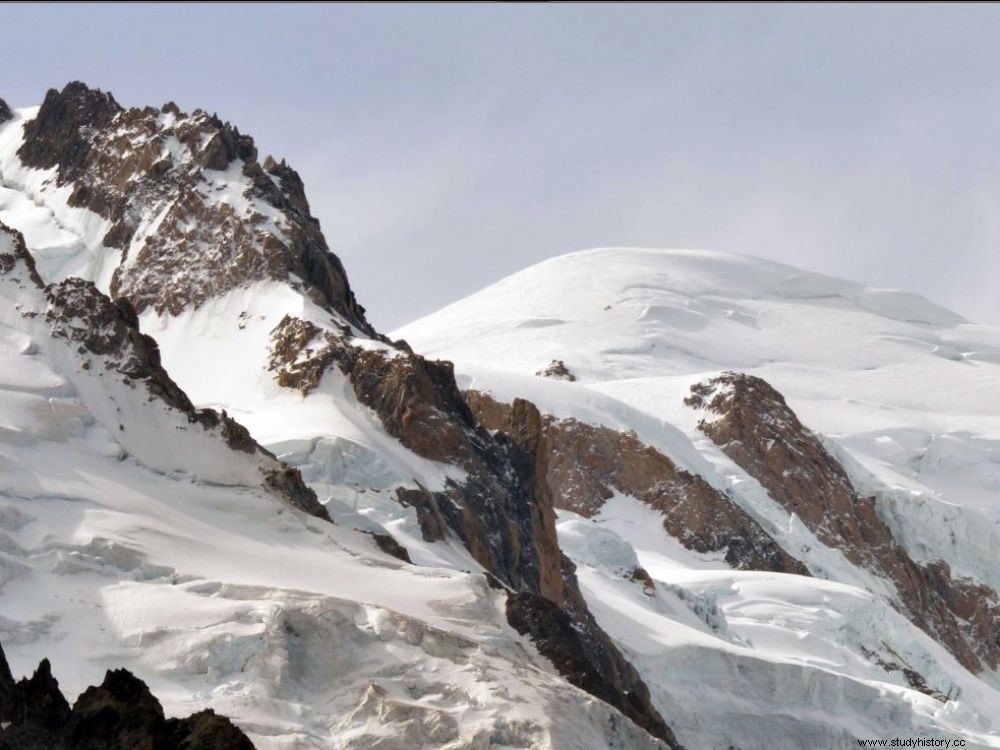The Alpine massif regularly restores human remains due to climate change and the constant retreat of glaciers.

Mont-Blanc Massif in Haute-Savoie.
The glaciers are gradually shedding their human remains. In mid-July, the Swiss gendarmes discovered a couple who disappeared 75 years ago, perfectly preserved, on the Tsanfleuron glacier, in the Diablerets massif, at an altitude of 2615m, in the Bernese Alps. On August 15, 1942, Marcelin and Francine Gautschy had left the village of Chandolin on foot to see their cattle and had never returned. The couple having certainly fallen into a crevasse during a violent storm, the searches had at the time yielded nothing... At the end of July 2017, a hand and a leg were this time found in the Massif du Bosson, on the French side of Mont-Blanc. Who do they belong to? For Commander Stephane Bozon, squadron leader of the High Mountain Gendarmerie Platoon (PGHM) in Chamonix (Haute-Savoie), "these remains probably do not come from the same body. They presumably belong to victims of the two Air India plane crashes over 50 years ago." . On November 3, 1950, a Lockheed Constellation, the "Malabar Princess had indeed crashed on the Mont Blanc massif, near the Rocher de la Tournette, at 4677m, with 48 people on board. Sixteen years later, on January 24, 1966, another plane from the same company, the "Kangchengjunga , a Boeing 707 from Bombay to New York, had "hooked" the mountain almost in the same place. Again, none of the 110 passengers and crew survived. Some dislocated bodies had nevertheless been collected, then lowered into the valley where they were buried in Saint-Gervais-les-Bains (Haute-Savoie).

Part of the cabin from the Air India Boeing 707, "Kangchenjunga", found in the Bossons glacier, in the Alps (Haute-Savoie), after its accident on January 24, 1966. © Daniel Roche /SIPA
Imprisoned by the glacier, buried under successive snowfalls, the remains of victims have since reappeared regularly, as have the metal parts of the cabins or even landing gear. "The glacier regularly rejects remains of this type, on the French and Italian slopes where, most of the time, they are left behind in their shroud of ice . We carry out real investigations with DNA research on the most complete bodies “, explains the commander, referring to the recent case of a mountaineer who disappeared in 1980 whose remains were found in 2014. As for small fragments such as those from these air disasters, it is the Public Prosecutor who takes the decision. action to be taken after receipt of the Gendarmerie reports.
In addition to the victims of these two tragedies, the Bossons glacier also contains many climbers whose bodies have never been found. Since 1960, the year from which these disappearances are recorded, about thirty have been officially declared and 150 for the whole of the massif, excluding air disasters! "We can imagine that this number is much lower than the reality, since the cases of disappearance have never been taken into account since Mont Blanc was climbed, that is to say the end of the 18th century. "
Due to the compression of the glacier during the creeping of its advance, the human or animal bodies trapped there are generally crushed. As they move, the colossal cascades of ice crush everything in their path. If discharges seem to be increasing, it is due to climate change and the constant retreat of glaciers. That of Bossons has regressed by 1200m since the beginning of the 20th century. In other regions of the world, the same scenes occur, including for ancient periods. In the Scandinavian countries, especially in Norway, elements of the Viking era were returned in 2012 in the Lendbreen glacier. When they are not bodies that disappeared more than 50 years ago, as was the case in 2015, across the Atlantic, with the mummified bodies of the Peak of Orizaba, in Mexico. The most famous glacial reconstruction remains, however, that of Otzi, a 5000-year-old man found in 1991, on the Italian-Austrian border, straight out of the Bronze Age.
